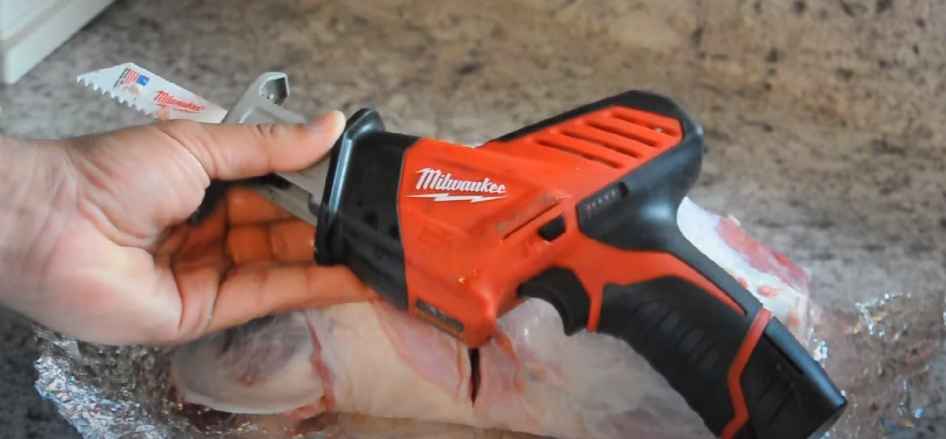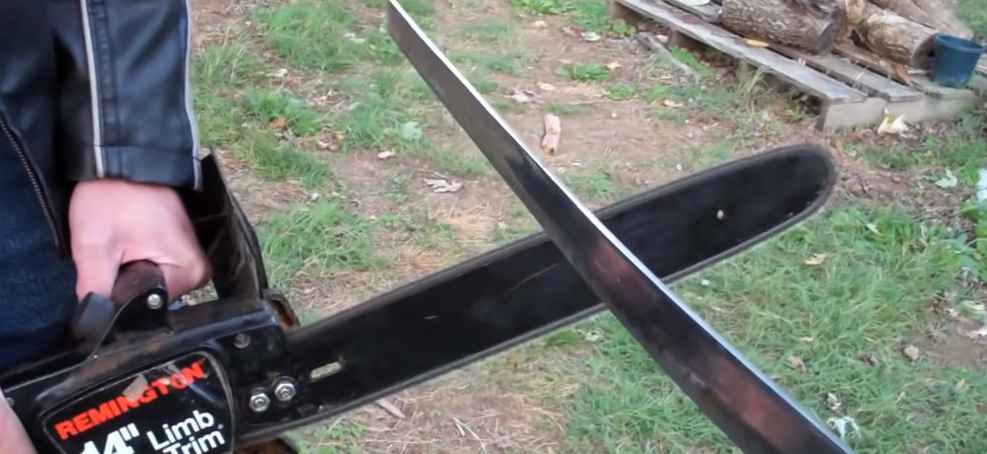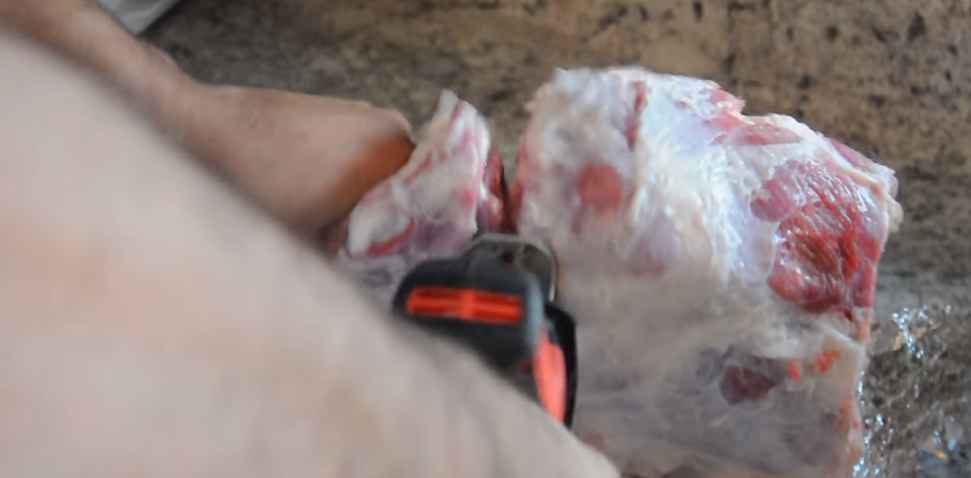A chainsaw can cut through bone if the blade is sharp enough. The saw must be moving quickly enough to sever the bone cleanly, otherwise it will get stuck.
A chainsaw can cut through bone if the blade is sharp enough. However, it is not recommended to use a chainsaw to cut through bone because it can damage the chain and cause the saw to kick back. It is also difficult to control the saw when cutting through bone.

Can a Chainsaw Cut off an Arm?
It’s a question that seems to come up a lot – can a chainsaw cut off an arm? The answer, unfortunately, is yes. Chainsaws are extremely powerful tools and can cause serious injury or even death if not used properly.
Even experienced users can make mistakes that result in serious injury, so it’s important to always be cautious when using a chainsaw. If you’re ever in doubt about whether you should be using a chainsaw, it’s always best to err on the side of caution and seek professional help.
What Tool Can Cut Through Bone?
One tool that can cut through bone is a power saw. This type of saw uses an electric motor to spin a blade at high speeds, allowing it to easily cut through bone. However, power saws can be dangerous to use and are not always the best option for cutting bone.
Another tool that can be used to cut through bone is a hacksaw. A hacksaw is a hand-held tool that has a thin, sharp blade that can be used to cut through bone. Hacksaws are less dangerous than power saws but may take longer to use depending on the thickness of the bone.
The best tool for cutting through bone will depend on the situation and what type of equipment is available. If time is not an issue and safety is a concern, then a hacksaw may be the best option. However, if speed is important, then a power saw may be the better choice.
Can Bone Be Cut Through?
Yes, bone can be cut through. However, it depends on the type of bone and the Cutting implement being used. For example, a knife would not be able to cut through a human femur, but a saw could.
Can a Chainsaw Cut off a Leg?
Chainsaws are powerful tools that can be used for a variety of purposes, including cutting through thick tree branches and felling trees. However, chainsaws can also pose a serious risk to users if they are not used properly. One of the most dangerous potential injuries that can occur while using a chainsaw is amputation of a limb.
While it is certainly possible for a chainsaw to cut off a leg, this is not necessarily common. Amputation usually occurs when the chain saw comes into contact with bone or another hard object, which can cause the blade to bind and stop abruptly. This can then lead to the operator losing control of the saw, which can result in the saw blade coming into contact with their limb.
If you are using a chainsaw, it is important to take precautions to avoid injury. Always wear proper protective clothing, including gloves, boots, and eye protection. Be sure to keep your fingers and hands away from the blade at all times.
If you must cut something that is close to your body, use extreme caution and be prepared to stop quickly if necessary.
Experiment: Chainsaw vs XXL Jelly
Can a Chainsaw Cut Through a Person?
A chainsaw is a powerful tool that can easily cut through wood. However, many people wonder if a chainsaw can also cut through a person. The answer is yes, a chainsaw can most definitely cut through a person.
In fact, this is one of the most common ways that people are injured by chainsaws. If the chain hits someone in just the right spot, it can easily sever an limb or even decapitate them. Of course, this doesn’t happen very often because most people are smart enough to avoid putting themselves in harms way when using a chainsaw.
However, accidents do happen and it’s important to be aware of the dangers of using this type of tool. If you’re going to be using a chainsaw, always be sure to wear proper safety gear such as gloves, goggles, and long pants. And never allow anyone else to stand close by while you’re operating the saw.
By following these simple safety tips, you can help prevent any tragic accidents from happening.
Can a Chainsaw Cut Through Metal?

A chainsaw can cut through metal if the right blade is attached. Typically, a steel-cutting blade with a carbide tip is needed. The teeth on these blades are designed to cut through tough materials like metal.
When cutting through metal, it’s important to go slowly and let the blade do the work. Trying to force the saw will only damage the blade and could cause serious injury.
Can a Chainsaw Be Used As a Weapon?
While most people think of chainsaws as being used for cutting down trees or trimming branches, they can actually be quite dangerous weapons. In the hands of a skilled user, a chainsaw can be incredibly deadly.
There have been numerous news reports of people using chainsaws to attack other people.
In some cases, the attacker will purposely rev the chainsaw and then swing it at their victim, causing severe injuries. In other cases, the attacker may simply use the chainsaw to cut through flesh and bone.
Regardless of how it is used, a chainsaw can cause serious harm to another person.
If you are ever faced with someone who is wielding a chainsaw, it is important to try to get away from them as quickly as possible. Do not try to fight back or reasoning with them – just get away and call 911.
Can a Chainsaw Kill You?
A chainsaw is a powerful tool that can be dangerous if not used properly. If you are hit by the chain of a chainsaw, it can cause severe injury or even death. The chain of a chainsaw moves at high speeds and can easily cause serious injury if it hits someone.
Bone Saw
A bone saw is a hand-held power tool that is used to cut through bone. It consists of a blade with teeth that are sharp enough to cut through bone, and a handle for the user to grip. The saw can be operated with one hand or two, depending on the size of the saw and the amount of pressure that needs to be applied.
Bone saws are typically used by surgeons, orthopedic surgeons, and funeral directors. They can also be used by hobbyists and do-it-yourselfers for tasks such as cutting chicken bones or trimming deer antlers. The most common type of bone saw is the reciprocating saw, which has a blade that moves back and forth in a slicing motion.
Reciprocating saws come in different sizes and with different features, such as variable speed control and adjustable blades. Some models even have built-in vacuum cleaners to collect dust and debris while you’re working. If you need to cut through bone, a reciprocating saw is likely your best bet – but make sure you get one that’s up for the task at hand.
Choose a model with sharp teeth and plenty of power, and follow all safety instructions carefully when using it. With the right tools and precautions, cutting through bone can be safe – and even easy!
Hand Held Chain Saw
If you’re looking for a powerful, yet lightweight hand held chain saw, then you’ll want to check out the selection of Husqvarna hand held chain saws. These Swedish-made saws are some of the best in the business, and they offer a variety of features that make them ideal for both home and professional use.
For instance, the Husqvarna 240 is a great choice for those who need a versatile saw for light pruning and general yard work.
It’s also one of the lightest models in the Husqvarna range, weighing just 5.4 kg (12 lbs). But don’t let its size fool you – this little powerhouse can still pack a punch, with a 2.2 kW (3 hp) motor that delivers up to 13 m/s (29 ft/s) chain speed. If you need something with more power, then take a look at the Husqvarna 350BT.
This model is designed for more heavy-duty jobs like felling trees or cutting large branches. It has a much higher chain speed than the 240 (20 m/s or 44 ft/s), and comes with an impressive 3 kW (4 hp) engine. Plus, at just 6.6 kg (14.5 lbs), it’s still relatively lightweight and easy to handle.
Mini Chain Saw

A mini chain saw is a great tool for anyone who needs to do some light cutting or trimming. They are much smaller and lighter than a full-sized chain saw, making them easier to maneuver and handle. And because they use a chain instead of a blade, they can make quick work of branches and logs.
If you’re thinking about purchasing a mini chain saw, there are a few things you should keep in mind. First, decide what size saw you need. There are many different sizes available, so it’s important to choose one that will be able to handle the type of cutting you’ll be doing.
Second, think about the power source. Some mini chain saws are cordless, while others must be plugged into an outlet. Choose the option that will be most convenient for you.
Finally, consider the price. Mini chain saws can range in price from around $50 to over $200.
Why was Chainsaw Invented?
Chainsaws are one of the most versatile and commonly used tools in the world. But have you ever wondered why they were invented in the first place? It all started back in the 1700s when a German engineer named Johann Georg Stahlbaum created a hand-powered saw that was specifically designed for cutting wood.
This early version of the chainsaw was incredibly inefficient, but it laid the groundwork for future inventors to build upon. In 1830, another German engineer named Bernard Heine improved upon Stahlbaum’s design by creating a steam-powered saw that could be used to fell trees more efficiently.
However, this early chainsaw was still quite cumbersome to use and wasn’t yet practical for widespread use.
It wasn’t until 1848 when two American inventors, Amos complishmentsl and James Bolter, finally created a workable chainsaw design. Their saw was powered by a gasoline engine and featured a chain with teeth that could quickly cut through wood. This design quickly caught on and became the standard for chainsaws over the next century.
While there have been many improvements and refinements made to chainsaws since their invention over 250 years ago, their basic purpose remains the same – to help us quickly and easily cut through wood.
Conclusion
It is possible to cut through bone with a chainsaw, but it is not advisable. Cutting through bone with a chainsaw can damage the saw and cause injury to the person operating it.